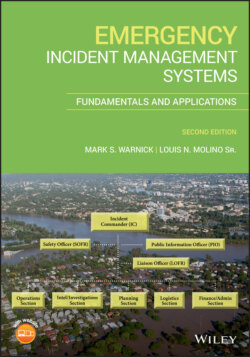Читать книгу Emergency Incident Management Systems - Mark Warnick S., Louis N. Molino Sr - Страница 61
2.6 Conclusion
ОглавлениеIn looking at the response to the Aum Shinrikyo attacks on the Tokyo subway system and comparing it to the Oklahoma City Bombing, it is obvious that there needed to be a clear command and control in Tokyo to effectuate a positive response. It should also be apparent that integration of resources, interoperability, and open communications would have improved the response. The integration of resources and the use of an IMS method should have been a long‐term goal long before the Tokyo incident ever happened.
Looking at the mistakes made in this subway attack, it is apparent that this was a critical incident that demanded a specialized response. Dissecting the response, it is noticeable that Chemical, Biological, Radiological, Nuclear, and Explosive (CBRNE) response standards were not met. Contaminated areas were not secured, and patients were allowed to leave the contaminated area without decontamination. Contaminated trains were allowed to keep moving while letting contaminated passengers board and leave the train, and there was evidently no command and control of any of the scenes. Add the lack of cooperation, coordination, and communication, and this response was a roadmap for disaster long before the incident ever occurred.
Instead of turning chaos into calmness, this response added to the chaos. Confusion ensued throughout not only the response but also through the entire investigation and even years beyond that day. Rather than removing the uncertainty, the Tokyo response added to the uncertainty, thereby substantially increasing it for many hours.
Through the use of an IMS method, these issues could have been mitigated, but only if the chosen IMS principles were practiced and used on a regular basis. In order to be effective, IMS methods need to become a response lifestyle, rather than using them for only major incidents. In a review of the incident, Pangi (2002) states that some method of IMS should be enacted in Tokyo, and throughout Japan. Had IMS principles and an IMS method been used, the outcome of the Tokyo sarin attack by Aum Shinrikyo would have likely been very different. It is likely that the death and injury toll likely would have been substantially less. Additionally, the incident likely would have been recognized as a terrorist attack utilizing a Weapon of Mass Destruction (WMD) substantially sooner. The earlier identification of this likely would have led to shutting down the train and securing the larger scene much faster. Secondary contaminations likely would have been reduced as well.
Utilizing an IMS method in the response mode would have been more effective because resources likely would have been identified, and specific tasks would have been assigned, based on the resource's abilities and equipment. There would not have been any duplication of resources, and personnel would have been more succinct operationally. If a Unified Command (UC) were set up, divisions could have been based on geographical areas. This would have allowed autonomy at a given site for the situation they faced, yet provided an integration of resources at a higher level.
Additionally, if an IMS method was integrated, public health authorities could have been brought into the mix, allowing them to know the number of patients and which hospitals were capable (and had room) for the type of injuries the patients suffered. Of course, this would have also provided clearly defined lines of who would be responsible for each aspect, and where strike teams and task forces were needed to improve the response. It also would have expedited the incident from a response into a recovery mode. This is based on the assumption that with a fully collaborative effort, ending the response mode would have occurred more quickly. Let us not forget that had an IMS method been used, the integration of the subway authority would have likely reduced the death and injury toll because that authority would have been informed sooner about the type of incident, thereby reducing the spread of the sarin contamination.
While there is no way to know for sure, it is believed that the Tokyo sarin attack and the Oklahoma City Bombing may have caused some countries around the world to rethink how they respond to major disasters. In other cases, major incidents that occurred in their country caused the responding agencies in other countries to create a system to better manage future incidents.
